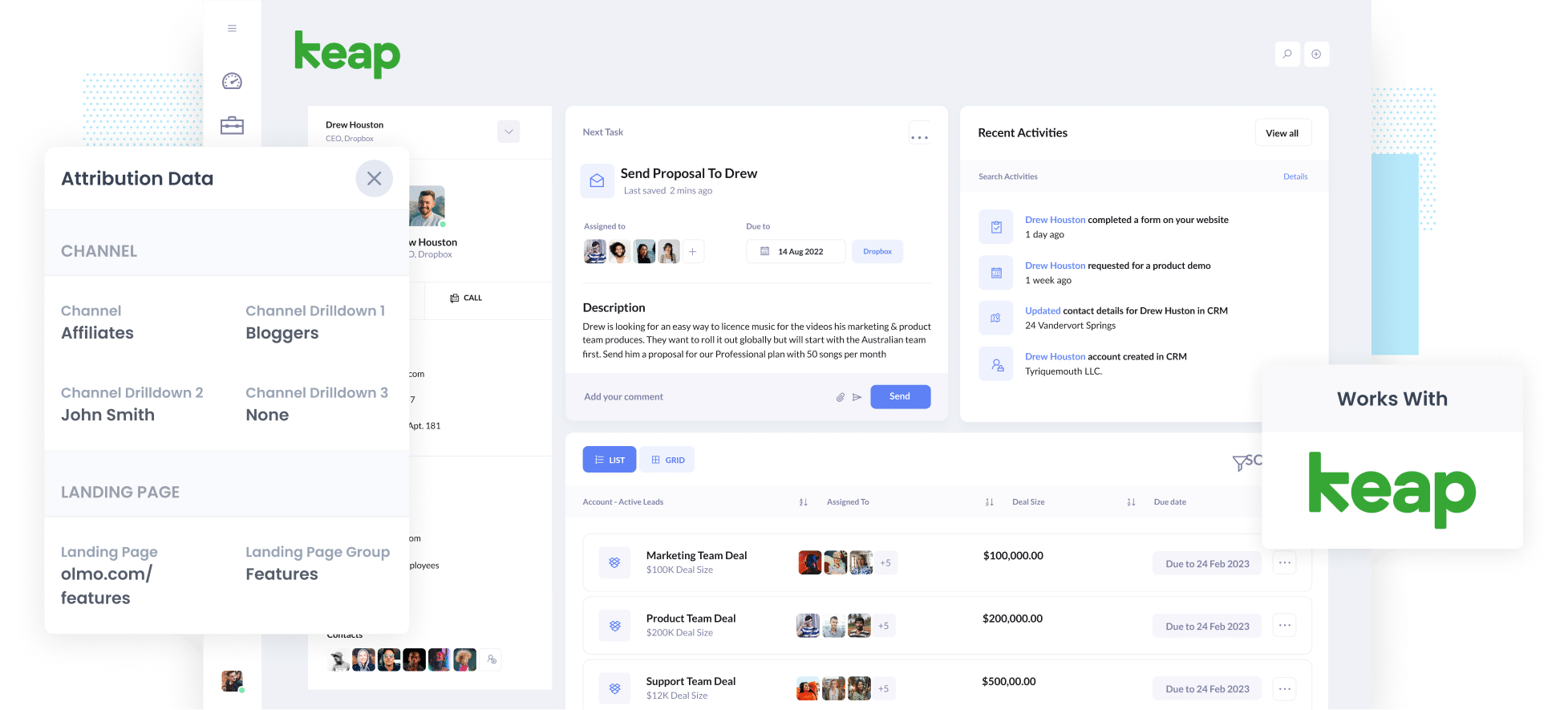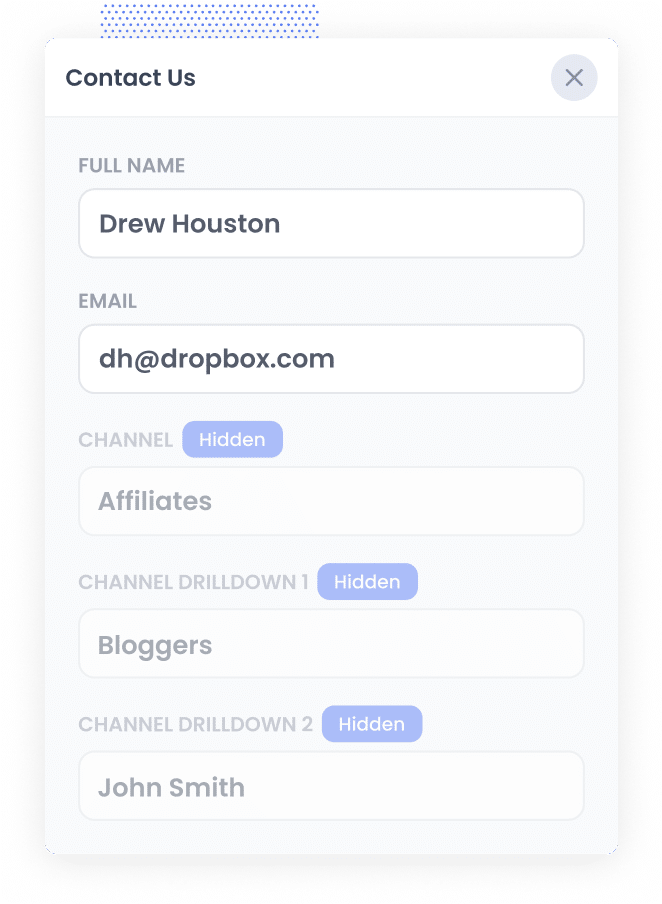Track how many leads you get from Affiliates in Keap
Learn how to track how many leads and customers you get from Affiliates in Keap

Keeping track of the number of leads and customers your Affiliates generate can be challenging.
While tools like Google Analytics make it simple to track website visitors, they can't help you when it comes to tracking how many leads & customers you got.
That's where Attributer comes in.
It allows you to capture data from your Affiliates with each form submission and send it to Keap, where you can run reports that shows how many leads you got from your affiliate program, which affiliates got you the most new customers, how much revenue was generated, and more.
In this article, we will walk you through the process of capturing affiliate data in Keap and provide you with some sample reports that you can run to see how your affiliate program is performing.
3 simple steps to track how many leads & customers you get from Affiliates in Keap
With the help of Attributer, you can track how many leads and customers you're getting from your affiliate program. Here's how it works:
1. Add UTM parameters to your affiliate links

When sharing links with your affiliates, always include UTM parameters.
For example, if you want them to link to attributer.io/integrations/keap, then ensure the link you give them would look a bit like this:
attributer.io/integrations/keap?utm_medium=affiliates&utm_source=bloggers&utm_campaign=john-smith
You can customise the UTMs to gather specific data about your affiliates. We highly recommend using something along the lines of the following:
- UTM_Medium = Affiliates
- UTM_Source= Bloggers (or the type of affiliate this is, such as bloggers, podcasters, YouTubers, etc.)
- UTM_Campaign= John-Smith (or the name of the specific affiliate)
If you use affiliate management tools like Trackdesk or Rewardful, then you can set them up to automatically add UTM parameters to the links that you share with your affiliates.
Alternatively, you can try our free UTM builder (which includes templates for affiliates to make them easier to create)
2. Add hidden fields to your forms

The next thing to do is to add a set of hidden fields to the forms on your website, like your Contact Us or Request a Quote page.
The hidden fields you need to add are as follows:
- Channel
- Channel Drilldown 1
- Channel Drilldown 2
- Channel Drilldown 3
- Landing Page
- Landing Page Group
Popular form-building tools, like Gravity Forms and Typeform, offer simple ways to add hidden fields to your forms. You can find detailed, step-by-step instructions for over 50 of the most commonly used form builders here.
3. Attributer writes the affiliate data into the hidden fields

When a visitor arrives at your site via an Affiliate link that includes the new UTM parameters, Attributer captures and retains those details in the visitor's browser. This allows them to browse your site before completing a form (or even leave and come back later) and the UTM's will be remembered.
Then when these users decide to fill out a form on your website, Attributer automatically writes the affiliate information (sourced from the UTM parameters) into the hidden fields within the form.
4. Affiliate data is captured and sent to Keap

Finally, when someone submits a form on your website, the data that Attributer wrote into the hidden fields is captured by your form tool and can be sent to Keap.
If you use Keap forms, this will happen automatically and you'll be able to instantly see the data on the contact record.
If you use a different form builder (like Gravity Forms, Typeform, Jotform, etc) then you'll need to send the data across using your form tools integration with Keap (or a third-party integration tool like Zapier).
What data gets captured in Keap?
You can pick and choose the data you want to collect in Keap.
To put it simply, Attributer collects data from the UTM parameters. So, any details you add in the UTMs (like affiliate name, affiliate category, and more) will be gathered by Attributer and then sent to Keap.
We recommend including the following information in your UTM parameters:
- UTM_Medium = Affiliates
- UTM_Source= Bloggers (or the type of affiliate this is, such as bloggers, podcasters, YouTubers, etc.)
- UTM_Campaign= John-Smith (or the name of the specific affiliate)
Then the following information would be captured in Keap:
- Channel = Affiliates
- Channel Drilldown 1 = Bloggers
- Channel Drilldown 2 = John Smith
As an added bonus, Attributer will also capture information on leads that come from other channels as well (like Organic Search, Organic Social, Paid Search, Paid Social, etc).
So, for example, if someone came to your site from an organic Google search, this is what might get passed into Keap:
- Channel = Organic Search
- Channel Drilldown 1 = Google (or the name of the search engine they came from)
- Channel Drilldown 2 = www.google.com.au (or the Google domain they came from)
- Channel Drilldown 3 = Olmo Software (or whatever the keyword they used to find your business is, when available)
3 example reports you can run when you capture affiliate data in Keap
1. Leads by Channel

Attributer tracks the source of all your leads, not just the ones from your affiliate program. This allows you to generate reports (like the one above) that show how many leads you get from various channels.
This information is useful for assessing the performance of your affiliate program in comparison to other channels like Paid Search, Paid Social, Organic Search, etc.
Understanding this data can help you decide where to invest your resources.
2. Customers by Affiliate Type

This report shows you how many new customers you've acquired each month through your affiliate program. It groups them based on the different types of affiliates who brought them in, such as bloggers, YouTubers, podcasters, and social media influencers.
By determining which types of affiliates are bringing in the most customers, you can gain some really helpful insights that can help you make smart decisions about what kind of affiliates you should be trying to recruit more of.
3. Revenue by Affiliate

This table shows how much new revenue has been generated from each of your affiliates.
It's super helpful for evaluating how well your affiliates are doing and using that info to make smart decisions about improving your marketing. For example, you can concentrate on bringing in more top-performing affiliates and spend less time on recruiting lower-performing ones.
How Attributer helped William Russell scale their affiliate program
William Russell, an insurance company specialising in health and life insurance for expatriates, recently faced an issue where their affiliate management software did not integrating well with their CRM.
This made it difficult for them to track the amount of leads, customers & revenue their affiliate program was generating.
That was until they found Attributer.
Now, they incorporate UTM parameters into all their affiliate links, and Attributer passes them through to their CRM each time someone clicks an affiliate link and completes a form.
This allows them to run reports inside their CRM and see the number of customers gained through their affiliate program, the amount of revenue generated, the lead to customer conversion rate, average deal size, and more.
With these reports, they can compare the performance of their affiliate program against other marketing channels, such as Google Ads and Facebook Ads, and see how effective it is.
"By using Attributer, we're able to track the amount of customers & revenue that come from our affiliate program, as opposed to just website visitors and leads. This has shown us that it's our most profitable channel and has helped us scale it"

William Cooper - Marketing Director @ William Russell Insurance

Wrap Up
Attributer is a great way to capture UTM parameters from affiliate links and send them to Keap.
By doing so, you can get valuable insights into your affiliate program's performance, including:
- How many new customers are coming from bloggers vs podcasters
- How much revenue is being generated by each affiliate
- What the lead to customer conversion rate is
- How the average deal size of customers from your affiliate program compare to customers from your Google or Facebook Ads
- And much more
The best part is that starting with Attributer is free and it usually takes less than 10 minutes to set up. Don't miss out – start your 14-day free trial today!
Get Started For Free
Start your 14-day free trial of Attributer today!

About the Author
Aaron Beashel is the founder of Attributer and has over 15 years of experience in marketing & analytics. He is a recognized expert in the subject and has written articles for leading websites such as Hubspot, Zapier, Search Engine Journal, Buffer, Unbounce & more. Learn more about Aaron here.
